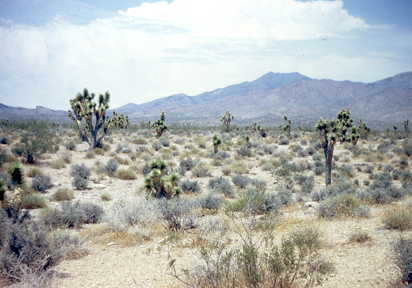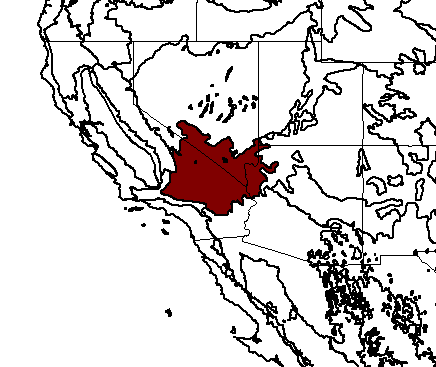
Yucca brevifolia (Joshua tree), Nevada (c) 2004 Maurice J. Kaufmann
Bioimages home (click on an image to enlarge)
view
this page in its intended navigation context
Mojave Desert
(WWF
ecoregion
NA1308)

Yucca brevifolia
(Joshua tree), Nevada
(c) 2004
Maurice J. Kaufmann

Source of bioregions data:
Olson, D. M. and
E. Dinerstein. The Global 200: Priority ecoregions for global conservation. (PDF
file) Annals of the Missouri Botanical Garden 89:125-126.
Distinctiveness (1=highest,4=lowest): 2
(regionally outstanding)
The elevation ranges from below sea level in Death Valley to over 1600m on some
mountains with most of the bioregion at elevations from 600 to 1200m. This
results in cold, dry conditions. The bioregion includes distinct endemic
communities and many species of endemic ephemeral plants.*
Conservation Status (1=most endangered, 5=most
intact): 4 (relatively stable)
About 50% remains as intact habitat. Threats include urbanization,
grazing, off-road vehicles, and military activity.*
 Larrea tridentata
Larrea tridentata Encelia farinosa
(brittlebush) (c) 2004
Maurice J. Kaufmann
Encelia farinosa
(brittlebush) (c) 2004
Maurice J. Kaufmann Yucca brevifolia
(Joshua tree)
Yucca brevifolia
(Joshua tree)Some views from the ecoregion
Desert vegetation, Death Valley, California





(c) 2005
Daniel P. Duran
hires
hires
hires
hires
hires
Desert washes, Death Valley, California




(c) 2005
Daniel P. Duran
hires
hires
hires
hires
Mountain slopes, Death Valley, California


(c) 2005
Daniel P. Duran
hires
hires
Joshua trees (Yucca brevifolia) , Death Valley, California




(c) 2005
Daniel P. Duran
hires
hires
hires
hires
Evaporation flats, Death Valley, California


(c) 2005
Daniel P. Duran
hires
hires
* Ricketts, T.H., E. Dinerstein, D.M. Olson, C.J. Loucks, et al. (1999) Terrestrial Ecoregions of North America: A Conservation Assessment. World Wildlife Fund - United States and Canada. Island Press, Washington, D.C. pp. 335-337.
Except as noted, images copyright 2002-2004 Steve Baskauf - Terms of use